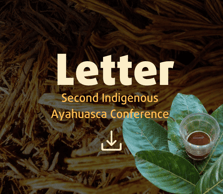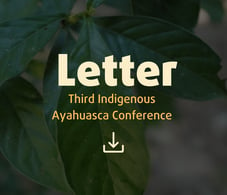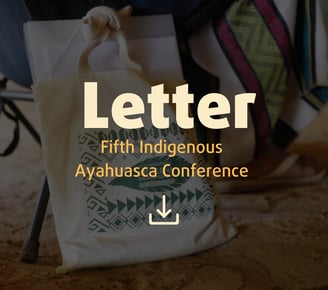


History
Discussions about the use, transportation, dissemination, and protection of knowledge, traditional wisdom, and genetic resources related to Ayahuasca have been intensifying since 2015. These discussions were initiated and led by indigenous peoples of Acre and later joined by other indigenous peoples of the Americas who traditionally use this medicine. The ritualistic and ancestral use of Ayahuasca forms the traditional basis of the spiritual and medicinal practices of many indigenous peoples. This beverage is of extreme importance for conducting rituals and perpetuating the ancestral knowledge and wisdom of these peoples for current and future generations.
The proposal to hold the first indigenous conference to discuss issues related to Ayahuasca was a reaction to the academic movement that almost exclusively dominated the discussions. This movement did not provide recognized and valued space for the voices of indigenous spiritual leaders, relegating them to mere minutes of participation without adequate space to share their knowledge, reflections, and contributions at events.
Despite the limited effective participation of indigenous peoples in these events, they underscored the need for deeper reflections on ways to protect traditional knowledge related to this medicine, especially considering the indigenous perspective and leadership. This is documented in the “Open Letter from the Indigenous Peoples of Acre on the World Ayahuasca Conference,” written in 2016 during the “II World Ayahuasca Conference,” organized by ICEERS (International Center for Ethnobotanical Education, Research & Service) in Rio Branco, Acre (attached to this site).
The importance of indigenous leadership in this discussion was publicly defended by Ashaninka leader Benki Piyãko. This stance was shared and adopted by Biraci Nixiwaka Yawanawa and Joel Dëvakï Puyanawa, who, along with other great spiritual leaders like Ninawa Pai da Mata Huni Kuin, reflected on the necessity of having a discussion space where indigenous peoples exclusively led through their spiritual leaders’ voices. This proposal was presented by Benki in December 2016 during the Assembly of Indigenous Organizations: OPITAR (Organization of the Indigenous Peoples of Tarauacá), OPIRE (Organization of the Indigenous Peoples of the Envira River), and OPIRJ (Organization of the Indigenous Peoples of the Juruá River).
After deliberation, representatives of indigenous communities presented the demand for an established dialogue space on the matter. It was then decided to hold an annual event, the official discussion space on issues related to Ayahuasca, a place of indigenous governance, which began in December 2017. The chosen format was a ‘conference,’ thus naming the event the “Indigenous Ayahuasca Conference.”
The first two conferences in 2017 and 2018, held at the Puyanawa people's homeland in Mâncio Lima, Acre, achieved a spectacular level of participation from indigenous peoples and others interested in this topic. The relevance of this debate, led by indigenous spiritual leaders and involving non-indigenous partners, sparked the interest of various societal layers, gathering participants from multiple countries and diverse Brazilian public institutions and civil society organizations, both national and international. The presence of magistrates from the Brazilian federal justice system gave the event significant legal importance for the discussed claims and themes.
The following editions in 2019 and 2022 were held at the Yorenka Tasorentsi Institute (IYT) in Marechal Thaumaturgo, Acre, chaired by Benki Piyãko. Combined, these events saw the participation of over three hundred representatives from the indigenous peoples of Acre, as well as from Amazonas, São Paulo, Paraíba, Paraná, Roraima, and Minas Gerais, and countries such as Peru, Colombia, Ecuador, Mexico, and Canada. The fourth conference included the Apolima-Arara, Huni Kuĩ, Jaminawa-Arara, Kuntanawa, Nawa, Noke Koi, Nukini, Puyanawa, Shanenawa, Shawãdawa, Yawanawá, Apurinã (Pupykary), Manchineri, Ashaninka, Ashaninka del Alto Perene, Yanesha del Puerto Yunnako, Nomatsiguenka, Ashaninka y Machiguenga del Rio Apurimac-Cusco, Yaminawa, Marubo, Yepá Mahsã-Tukano, Anishinaabe, Arhuaco, Tubú Hʉmmʉrimasa, Inga/Union de Médicos Indígenas Yageceros de la Amazonia Colombiana (UMIYAC), Kichwa de Sarayaku, Kofan, Jiaki, Wixárika, Potiguara, Omágua Kambeba, Shipibo-Konibo, Yanomami, Guarani Mbyá, and Siona.
The event also featured the participation of various national and international institutions, political authorities, researchers, and diverse partners. More than six hundred participants attended the last two editions.
The themes discussed in 2022 deepened issues that had been debated since the first conference, adding others that contributed to the excellent reflections made throughout the event. The experiences presented by each indigenous people pointed to a variety of ways to address diverse and often common issues, highlighting the importance of this space for dialogue and exchange.
We are moving towards the fifth edition of this important event, this time at the Sacred Village, home of the spiritual leaders Nixiwaka Yawanawa and Putanny Yawanawa, in the Rio Gregório Indigenous Land, in the municipality of Tarauacá, Acre, from January 25 to 30, 2025.
In a continuous process of strengthening this space for discussion and deliberation, the V Indigenous Ayahuasca Conference will represent a strategic and essential step not only in consolidating indigenous governance but also in defining some fundamental bases for the creation and functioning of the Indigenous Spiritual Leaders Council (CLEI), which has been discussed since the first conference.
Moreover, this will be a decisive moment for an urgent issue that raises concerns and mobilization among indigenous leaders and other indigenous peoples around the world: the protection of genetic knowledge and the fair sharing of benefits related to it.
As previously presented, we firmly believe that the conferences represent the struggle and cultural resistance of these indigenous peoples from the crucial point that unites them:





(…) the worldview intimately linked to environmental and spiritual ecology, uniting the human with the “non-human.” This perspective, which for years remained hidden due to invisibility imposed by governments and often discredited by science, foundational philosophy, and policies of Western society, has gained space in recent years through increased interactions between spiritual leaders and sectors of this colonizing society. This sector recognizes the importance of these peoples and their worldview for addressing various dilemmas and evils plaguing the current world structure, which is entirely imbalanced and harmful to the environment and human existence. It also calls for the deconstruction of false concepts and changes in the legal perception of countries where organized groups use different medicines.
Executive Report IV Indigenous Ayahuasca Conference, IYT 2023.12
It is important to note that the term Ayahuasca does not replace the terminologies presented by each participating people, such as Kamarãpi, Uni, Huni, Dispãnī hew, Tsĩbu, Yage, Gaapi, Caapi, Hayakwaska, among others. However, since the first Conference, it was agreed to use this term generically, encompassing all other nomenclatures.
Timeline

Collection












FREQUENTLY ASKED QUESTIONS


What is the Indigenous Conference on Ayahuasca?
The Indigenous Conference on Ayahuasca is an important discussion and deliberation space for Indigenous peoples on the uses, customs and sharing of knowledge about traditional medicine. Today the Conference is on its fifth edition.
How many days is it?
The Indigenous Conference on Ayahuasca will go on for five days.
Is the Conference open to the public? Is there a charge?
The Conference is a closed event. There is no charge. Only the presence of previously chosen guests is permitted. The necessary limit on the number of participants guarantees spaces of open and safe discussion for the Indigenous peoples
When does the Conference start?
The fifth edition of the Indigenous Conference on Ayahuasca will occur from January 25 to 30, 2025.
Where will the Conference be?
Aldeia Sagrada, Yawanawa People, Rio Gregório Indigenous Land, municipality of Tarauacá/AC
Will space be made available for the purchase of items and handicrafts?
During the event, areas will be available for the consumption of products such as fruit juice and coconut water, and for the purchase of Indigenous handicrafts.


Is there Internet access at the location?
Internet access will be available only for the event organizers, allowing the participants to effectively honor the debates during the Conference by avoiding unnecessary distractions during the sessions.

Will there be basic health care?
The event will rely on basic medical and nursing services, called to action when necessary. However, if the participant uses any medication, the prescription, purchase and treatment will be of their own exclusive responsibility.

Is there an agenda for the event?
The agenda will be disclosed only to the invited participants at an opportune moment.

Are photography and video recording permitted at the event?
Only Indigenous peoples and the people and teams authorized by the Conference organization may make photographic, video or audio recordings. The limitation on these activities aims to guarantee a safe environment of open discussion for the participants.



























